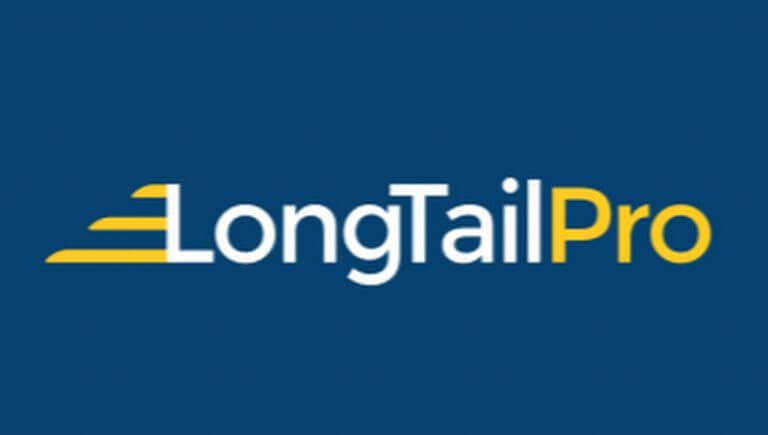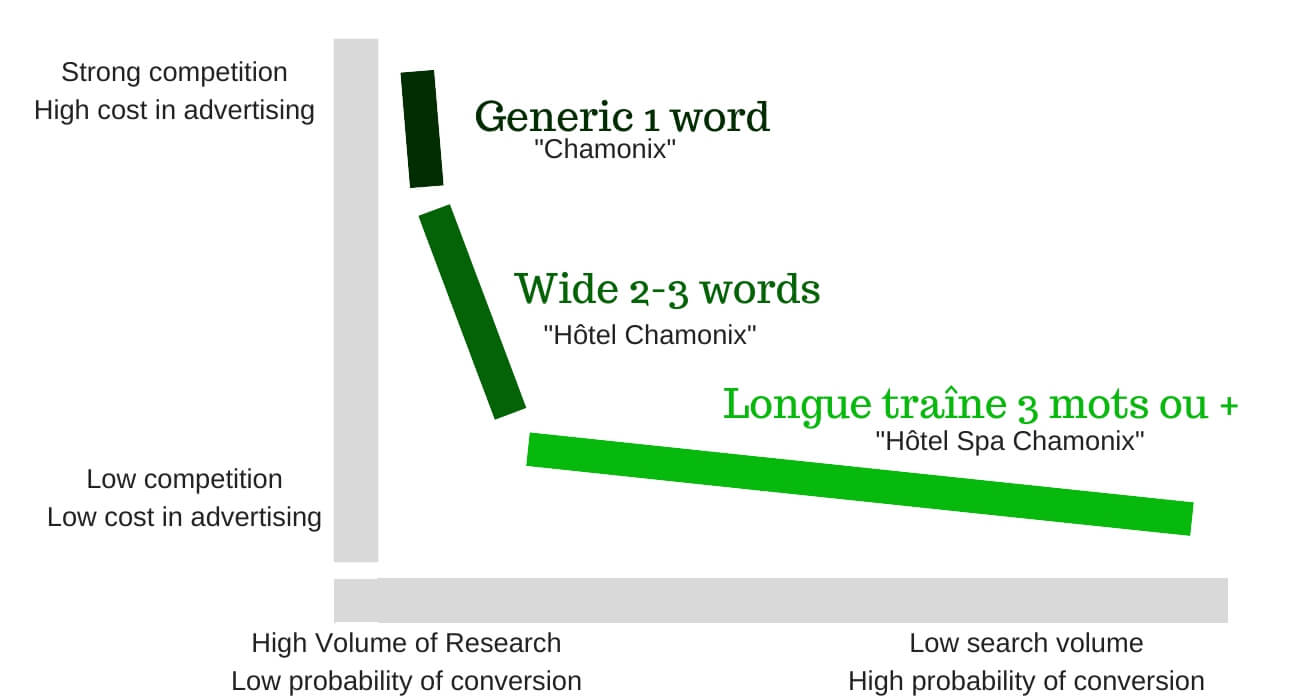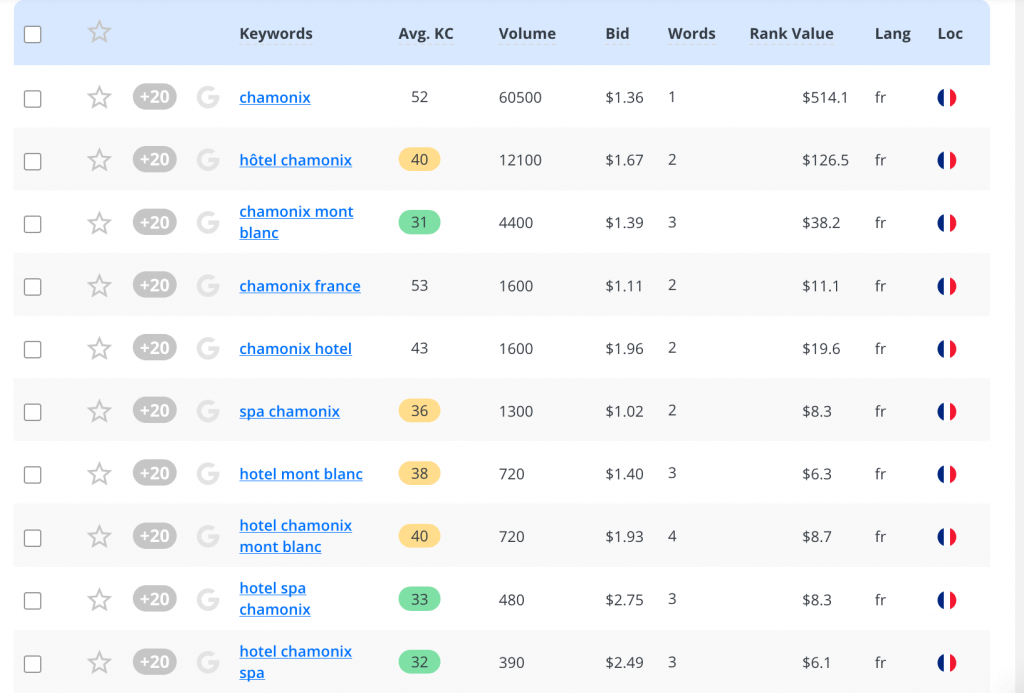
Our Novo-Media blog is brand new and in the coming months we will share with you many articles on topics such as social medias, web development but also our favorite: Organic Search. To start this series of articles about SEO we wanted first of all to introduce you a tool to search for keywords that we have been using for more than 3 years now: Long tail Pro
We have been blogging for almost 6 years now on Novo-Monde.com and over the years we have developed many SEO skills. We never went to the dark side and tried black hat SEO (techniques to influence the ranking of content that are contrary to Google’s policies).
On Novo-Media we will only talk to you about what we know, i.e. the creation of 100% relevant content and organic traffic.
NB: In this article our links to LongTail Pro are affiliate links, this means that we get a small commission if you use our links to buy the software. Beyond the affiliate links we are not employed or in partnership with this company. We recommend their product because we have been using it for a long time and we find it efficient (we also pay for our license).
The different traffic sources of a website
The traffic of a website generally comes from 6 main sources:
- Organic traffic: it is the traffic coming from search engines like Google, Bing, Yahoo Search, Ecosia, etc….
- Direct traffic: This traffic is the one coming from users who enter your url directly in the navigation bar. These are usually people who are already customers or who have been brought in through print/TV or radio advertising
- Paid traffic: It is also traffic from search engines, but this time from the paid part (SEM)
- Social Medias: Social networks can, if used properly, be an excellent source of traffic for your website. Example of social networks that can generate traffic to your site: Facebook, Twitter, Instagram, Pinterest, Youtube, Linkedin, etc.
- Referal traffic: This traffic is the one that comes from other sites that have mentioned you and linked to your site.
- Emails: E-mail marketing is also a powerful tool for building reader loyalty.
In our future articles we will discuss the different sources of traffic in detail, but be aware that having good reflexes in terms of keywords is essential for almost all sources of traffic.
The importance of working on your organic traffic

Being present online has become essential for almost all sectors of activity. But very often, having a simple website is not or no longer enough to be found by potential customers.
In the year 2000 there were roughly 17 million websites…. Today, in 2018, the web has more than 1.3 billion websites! Of course your site will not be in competition with all the sites, but you should be aware that there are more and more players present and that today more than ever it is essential to take care of its content to appear in search results and build reader loyalty.
Finding the right keywords: a long-term task
To understand the importance of keyword research and the impact that a resonant choice can have, here is a small concrete example:
Imagine that you are a brand new hotelier in the upscale resort of Chamonix and you are creating your website. Your first reflex will probably be to define yourself as a “Hotel” and then as a “Hotel in Chamonix”.
Certainly… But orienting your SEO around these keywords is a very bad idea if you want our opinion! Although these 2 keywords generate a lot of monthly searches, the competition is also very strong.

Statistically speaking there is almost no chance that your brand new website will appear on Google’s first page for these queries. Knowing that more than 90% of people never venture beyond the first page of results, betting on these keywords is clearly too risky.
To optimize your results it is therefore important to find the right keywords that have enough research volume to be interesting but where competition is within our reach.
And that’s precisely where tools like Lon gtail Pro come in.
The different types of keywords: generic, wide and long tail
Before continuing, it is important to quickly define the notion of keyword and its derivatives. We will devote other more specific articles to this topic in the future, but in order for you to understand well the different points on which Long Tail Pro can help you, it is essential to cover the basics quickly.
What is a keyword in principle? A keyword is a word (or a small sequence of words) that defines a theme or a web page. Keywords are what help search engines to identify relevant content for a user who performs a search.

Generic keyword
A keyword called generic is generally only 1 very global word. It is characterized by a high volume of research but generally gives few specifications on what the person is looking for. In our example it could be “Chamonix”.
Wide Keyword
A keyword called “wide” is very similar to the generic one but it still gives additional indications about the person’s intentions. A good example in our case would be “hotel Chamonix”. We know that the person is looking for accommodation and does not want ski lessons or pictures of the Mont Blanc… A good start! It is often on this category of keywords that the vast majority of booking platforms and major hotels position themselves when it comes to Google AdWords.
Long tail keywords
A long tail is defined as a sequence of words entered in Google that gives a clear indication of what the person is looking for. Naturally the volumes are lower but on the other hand the conversion on the sites is generally better and above all, most importantly, the competition from other websites is reduced. In our example it could be something like “hotel spa Chamonix” or “family hotel chamonix”.
In terms of the length of these keywords there is almost no limit, even if beyond 4-5 words it becomes complicated to guess exactly what terms are being searched for.
How does Long tail Pro works?
Long tail Pro is a powerful tool that allows you to accurately measure in a few clicks the search volume associated with a particular keyword (or series of keywords) as well as the competitiveness on the latter.
LongTail Pro will not automatically give you the keywords to rank yourself on, but its results are a valuable help in creating your keyword lists and also the so-called long tail keywords. In the example below we will continue with Chamonix as a generic keyword and “Chamonix hotel” as a broad term. For the long tail we decided to choose spa, but it could have been the ski rental, a family hotel, the best pancakes, etc….
The most used feature of Long tail Pro is most probably the analysis and suggestion of keywords. The tool allows you to enter keywords for a specific theme, define the country and/or language of the search, and the number of new suggestions desired for each keyword.
If we use our example of Chamonix here is the result obtained (by classifying the results by search volume):

Understand the results of Long Tail Pro:
When you do a search with Longtail Pro you will have a table in front of you. This table will include a number of rows (one for each keyword searched as well as for the automatic suggestions of the tool) and several columns.
To better understand, let’s review the columns:

- the selection column: allows you to select one or more keywords to delete/hide them or move them around in a project
- bookmark a keyword
- the analysed keyword: attention we are talking about exact wording here. Thus the term “Chamonix” only shows results for people who have typed only “Chamonix” in their search bar. Those who have entered “chamonix hotel” are excluded on this line
- Keyword competitiveness of the keyword (KC = Keyword competitiveness), this is a score calculated by the platform that gives an indication of how easy it would be (in absolute terms) to position yourself on Google’s first page. The lower the score, the better!
Estimation of significance by score range:
0 -10: Almost no competitiveness (these are extremely rare or even non-existent)
11-20: Very low competitiveness (it is very easy even for a brand new site to place itself on these keywords)
21-30: Low competitiveness (generally within reach of small sites starting up)
31-40: Average competitiveness (A good objective for an already well-established site)
41-50: Quite high competitiveness (You have to have an already authoritative site in the field to hope to compete)
51-60: Very high competitiveness (It is extremely difficult to position yourself on the first page)
61-100: Don’t even think about it! The word “Google” for example is at 68…. Needless to say, if your site is on the first page of this request you are probably not reading this article. - Search volume: this gives the number of times the exact keyword was searched during the previous month (depending on the language and country defined in 10 and 11)
- Bid: an estimate of the amount you would need to invest in Adwords for this keyword
- Competitiveness: A subjective measure of 1 to 3 of competition on this keyword within Adwords (we generally exclude this point for searches)
- The number of words that make up your keyword
- An estimate of the value of this keyword in the event that you place yourself in first place in Google on the latter
- The language in which the person is conducting the search
- The country from which the person is conducting the search
To find the right keywords, we will generally focus on column 4 and 5. A good keyword is a keyword with as much research volume as possible while having a competitive score within reach.
In order to know what score you can aim for with your domain name, know that Longtail Pro offers you to enter the name of your site and it will calculate your “maximum KC”.
The example of Chamonix explained in a few words:
- The term “Chamonix” is searched more than 60,000 times a month on google france. This keyword is called “generic” because it does not specify anything about what the person is looking for. The potential customer may be looking for accommodation, a restaurant, ski lessons or perhaps they simply want to look at pictures of the Mont Blanc or find a hike.
- Competitiveness is very strong on this keyword and the probability of succeeding in positioning on the first page is extremely low
- The keywords “chamonix hotel” or “chamonix hotel” are called wide. Volumes are lower, but research is more focused.
- The keywords “hotel spa chamonix” or “hotel chamonix spa” can be considered as long tail. Their volume is lower but competitiveness lower and here we know exactly that the potential customer is looking for a hotel with a spa in Chamonix.
Be careful: Keyword research tools are important and efficient, but it is essential to remain in a coherent and above all effective approach. If, for example, your hotel in Chamonix does not have a spa, it is absolutely useless to want to position yourself on this keyword. It is not excluded that by focusing on “Hotel Spa Chamonix” you may be able to generate traffic even if your hotel does not have a spa. But do you really think this traffic will convert? We doubt it…
NB: This small section is not intended to be a complete tutorial on how to use Longtail Pro here. This article is simply informative and aims to present the platform in broad terms. We will discuss work and research methodologies in more detail in future articles.
Prices of Log Tail Pro
Longtail Pro is a paid software and is available as a subscription (which can be monthly or annual). As is often the case, taking out an annual subscription is cheaper than opting for the monthly formula (which can be cancelled at any time).
In monthly, LongtailPro is available starting at $37 per month. For the annual, a 33% discount is granted and the monthly price increases to $25 per month.
How to use long tail pro everyday?
Here is a short video that explains in a little more detail what LongTail Pro can do
We use long tail pro for mainly 2 things:
- Optimize static content such as the home page and pages of our site (or those of our customers): We have created a list of keywords on which we are looking to position our site. Thanks to a tracking file we analyze which keywords bring us the most traffic and especially which convert. Thanks to LongTail Pro we regularly search for new keywords and test new combinations.
- Help us on a daily basis to write blog articles. When writing a blog article (for us or for a customer) it is important to remain natural and spontaneous. Nevertheless, for some key publications, we do an analysis of the keywords that revolve around the theme of our article. Sometimes a simple variation in its title and main keyword can make a significant difference in the results.
Convinced? Want to try it? Longtail Pro offers a 10-day money-back guarantee.

